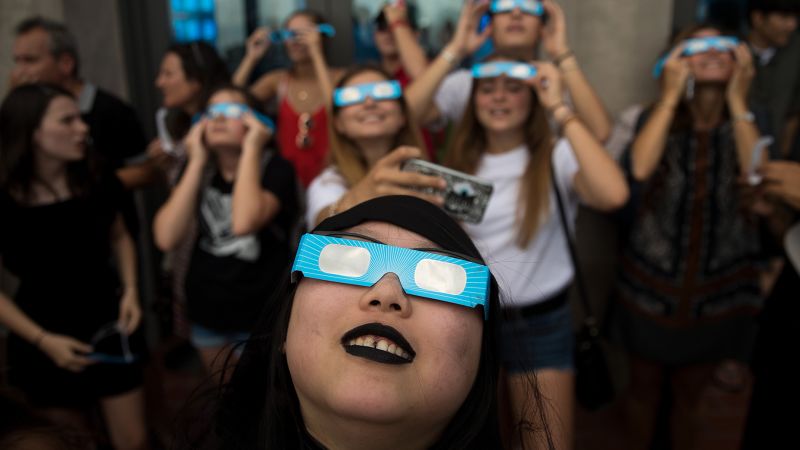As the total solar eclipse, occurring across Mexico, the United States and Canada on April 8, draws near, experts are reminding spectators to grab a pair of eclipse glasses to view the celestial event safely — and to make sure they aren’t fake.
Counterfeit eclipse glasses are “polluting the marketplace,” according to a release shared by the American Astronomical Society, or AAS.
A total solar eclipse occurs when the moon passes between Earth and the sun, completely blocking the sun’s face from view for a few moments. About 32 million people in the US live within the 115-mile-wide (185-kilometer-wide) path of totality, or locations where the moon will appear to completely cover the sun and the lunar shadow falls on the Earth’s surface. People outside the path of totality will still be able to see a partial solar eclipse in which the moon only blocks part of the sun’s face.



Welding mask, soldering doesn’t usually require any special eye protection
As others have said, only the darkest shades of welding glass provide adequate protection, and the ones that do are fairly uncommon, most hardware stores and even many welding supply places won’t won’t have dark enough masks or glasses on-hand normally. They may be able to order them, but don’t expect to pick them up off the shelf at your local store.
Guess thats why you shouldnt listen to internet randos :v
Yeah, in English soldering and welding are different processes, there’s also brazing, which really kind of mucks the terminology up.
I’m sure you’re probably pretty familiar with the actual processes (probably moreso than me, most of my knowledge is second-hand from growing up with my pipefitter dad and hanging out with a few welders,) but just so you know how we use the terms in English (and for anyone else who’s reading this who might be curious)
What we call soldering is a relatively low temperature process, the filler metal gets melted but not the base metal, it’s often done with a soldering iron, or regular butane, propane, or mapp gas torches, usually with no need for an oxygen torch.
Brazing is basically just hotter soldering, the base metals still aren’t getting melted, it may involve an oxygen torch, there’s also some brazing processes that use arc welders, like TIG brazing with silicon bronze filler.
For the non-welder types, you can kind of think of soldering and brazing as metal hot glue. There’s a bit more to it than that, but that’s kind of the general idea.
And welding is when the base metals are getting melted together, and it’s pretty much always going to involve either an arc-welder or oxy-acetylene torch.
Most hardware stores probably stock about a shade 10 lens, which is adequate for most common welding processes. You really only need to go higher for a handful of processes, like carbon arc welding (darker lenses may be recommended in a lot of other cases, but 10 will meet or exceed the minimum requirement in most cases)
I’ve seen some mixed information about exactly what shade is safe for viewing the sun, but they all agree that 10 isn’t adequate, I’ve seen some sources that say anything darker than 10 is ok, others say darker than 12, and still others insist on 14. It’s probably one of those things that depends a lot of factors, how long you look, how sensitive your eyes are, the weather, viewing angle, etc. I’m no expert and certainly don’t take this as legit safety advice, but I’d imagine you could probably steal some quick looks at the sun with shade 10 or so lenses without causing significant damage, but you probably don’t want to stare at the sun for a few hours for the whole duration of the eclipse.
I have seen a lot of auto darkening helmets that go up to a shade 13. So if you have one, think that’s an acceptable level of risk, and can either set it to 13 or trust it to do it automatically (I kind of suspect, though I don’t know for certain, that looking at the sun may not trigger it as reliably as looking at a weld that’s right in front of you) you can certainly try that.
I suppose there’s also the possibility that the equivalents of ANSI or OSHA or whoever sets the standards for welding lenses in your country, may use a different system or terminology than we do here in the states, which could make most of what I’m saying here largely irrelevant.
Personally I have a pair of glasses made by Phillips safety with shade 14 glass that I used for the last eclipse and will use again for this one. I certainly felt well-protected, the sun was just a dim circle in the sky. Of course the apparent brightness is only part of the issue since UV light is invisible and that’s where a lot of the real danger comes from, but a shade or two lower probably would have still made the sun comfortable to look at, though I can’t comment on the actual safety.
So the conclusion is: Test your eye protection, whatever it is, like the article says.
I have heard those words before but forgot about them and often get confused with the meanings. Thanks for the explanations, good read.
Those look awesome but they are too expensive here and I always worry they will take too long to darken
Probably. I think we are also a bit careless when it comes to safety measures. Like Ive seen DIY videos on YT that makes me think the maker is being a bit paranoid about safety only to then read the comments telling them all the other safety measures they skipped and all I can think of is “I would have done it worse” lol.